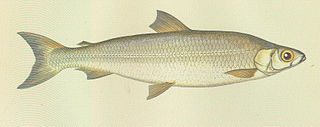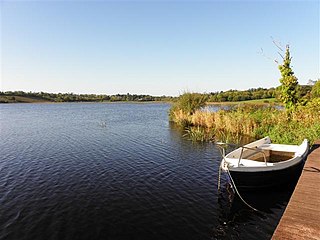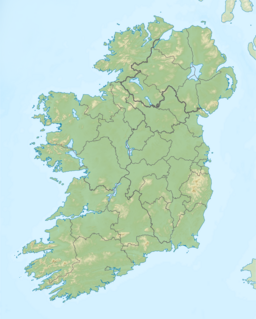
The zebra mussel is a small freshwater mussel. The species originates from the lakes of southern Russia and Ukraine, but has been accidentally introduced to numerous other areas and has become an invasive species in many countries worldwide. Since the 1980s, the species has invaded the Great Lakes, Hudson River, and Lake Travis.

Lough Allen is a lake on the River Shannon in northeastern Connacht, Ireland. Most of the lake is in County Leitrim, with a smaller part in County Roscommon. The lake lies to the south of the River Shannon's source, near the Iron Mountains, and is the uppermost of the three main lakes on the river. The other two, Lough Ree and Lough Derg are much further to the south.

The quagga mussel is a species of freshwater mussel, an aquatic bivalve mollusk in the family Dreissenidae. It has an average lifespan of 3 to 5 years.

The pollan or Irish pollan is a freshwater whitefish known only from five Irish lakes, Lough Neagh, Lower Lough Erne, Lough Ree, Lough Derg and Lough Allen. The pollan faces competition from introduced species such as pike, roach and zebra mussel, and the populations rely on restocking for survival.

Lough Melvin is a lake in the northwest of the island of Ireland on the border between County Leitrim and County Fermanagh. It is internationally renowned for its unique range of plants and animals.

Lough Sheelin, in standard Irish Loch Síleann, is a limestone freshwater lough (lake) in central Ireland. The lake is a part of the River Inny course, and ultimately of the Shannon system.

The Muintir Eolais of Conmaicne Réin, were nobles of Gaelic Ireland. For seven hundred years from the 8th century, they lived and ruled an area roughly conterminous to present-day south County Leitrim. Their territory comprised the lands named Maigh Nissi and Maigh Rein, today the baronies of Leitrim and Mohill respectively.

The barony of Mohill is an ancient barony in County Leitrim, Ireland.

Glencar Lough, locally known as Glencar Lake, is a freshwater lake in the northwest of Ireland. It covers an area of 1.15 square kilometres and lies mostly in County Leitrim with a smaller part in County Sligo. Glencar Waterfall is located near the lake's north shore on the Leitrim side.

Glenade Lough, locally known as Glenade Lake, is a freshwater lake in the northwest of Ireland. It is located in north County Leitrim in the Glenade Valley.

Garadice Lough (Irish: Loch Guth Ard Deas, also known as Garadice Lake or Lough Garadice, is a freshwater lake in County Leitrim, Ireland. It is located in the south of the county and now forms part of the Shannon–Erne Waterway.

Lough Scur is a freshwater lake in south County Leitrim, northwest Ireland. It is part of the Shannon–Erne Waterway. There have been Human settlements here since the New Stone Age. Modern features include quays and moorings. Protected features are Castle John, three Crannogs, and the causeway into Rusheen Island, though "Jail Island" is not protected. The ecology of Lough Scur, and indeed all county Leitrim lakes, is threatened by pollution and invasive species such as curly waterweed, zebra mussel, and freshwater clam.
St. John's Lough, also known as St. John's Lake, is an irregularly shaped freshwater lake located in south County Leitrim, in northwest of Ireland. The lake forms part of the wider Shannon–Erne Waterway tourist attraction. The ecology of John's Lough, and the Shannon-system, is threatened by pollution and invasive species such as curly waterweed, zebra mussel, and freshwater clam.

Belhavel Lough is a freshwater lake in the northwest of Ireland. It is located in north County Leitrim near the village of Killarga.
Carrickaport lough is a freshwater lake in Kiltubrid parish, south County Leitrim, northwest Ireland. Drumcong village, and Lough Scur, lie nearby. Carrickaport lough is known for quality bream and pike fishing. The ecology of Carrickaport lough, and other Leitrim waterways, is threatened by curly waterweed, zebra mussel, and freshwater clam invasive species.
Keshcarrigan lough is a mesotrophic freshwater near Keshcarrigan village, in northwest Ireland. Known for quality coarse fishing, Keshcarrigan lough allows bank fishing from concrete stands on the northern shore, two with wheelchair access. The ecology of Keshcarrigan lough, and other Leitrim waterways, is threatened by curly waterweed, zebra mussel, and freshwater clam invasive species.

Castlefore Lough is a mesotrophic freshwater in northwest Ireland. Known for good coarse fishing, Castlefore Lough has limited bank fishing. The ecology of Castlefore Lough, and other Leitrim waterways, is threatened by curly waterweed, zebra mussel, and freshwater clam invasive species.
Lough Marrave is a small freshwater lake in county Leitrim in the northwest of Ireland.
Drumaleague Lough is a very small freshwater in northwest Ireland. The ecology of Drumaleague Lough, and other Leitrim waterways, remain threatened by zebra mussel and other invasive species.
Lough Conway is a very small freshwater lake in northwest Ireland.















